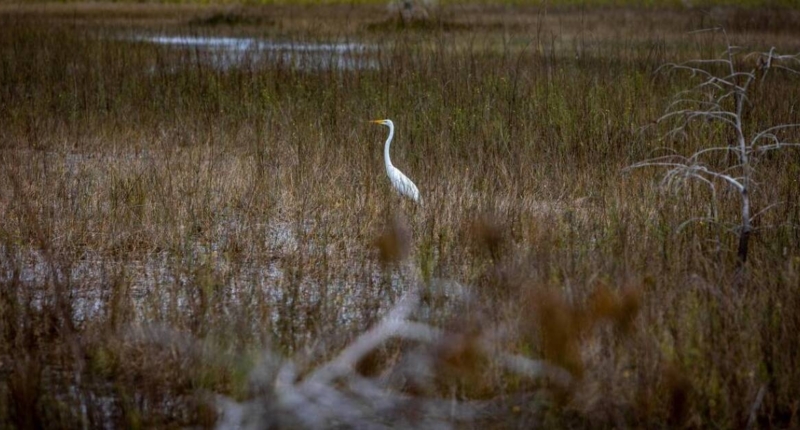The restoration of the Everglades is showing promise, with signs of progress emerging in the effort to restore the natural flow of water to the southern Everglades while protecting neighboring communities from flooding. Recent efforts have led to the resurgence of wildlife, such as alligator nests and nesting bird colonies, and the soggy, mucky peat soil that lives underneath the fields of sawgrass in some parts of the Everglades is now staying wet, reducing the risk of wildfires. However, the western Everglades is not showing improvement, and advocates are urged to center native voices in Everglades restoration and prioritize western Everglades restoration. Despite this, advocates remain optimistic that progress will continue with the raising of the Old Ingraham Highway and a new Lake Okeechobee water management system that will send more water south.
Signs of Everglades Restoration Progressing, but Full Recovery Still a Long Way Off
The efforts to restore the Everglades, a multibillion-dollar project that has taken decades of planning and political support, is finally showing signs of success. The National Park Service scientist, Melodie Naja, states that they are trending in the right direction, although there is still a long way to go.
The measure of success for state and federal agencies has been to get the water flow right, which is not an easy feat. The restoration process requires more water to be sent through the parched southern Everglades into Florida Bay, while ensuring that neighboring communities are not flooded in the process.
The most encouraging sign that the restoration efforts are bearing fruit is the resurgence of wildlife in many areas across the system, which is an important measuring stick of a healthy Glades. During a tour of state-owned wetlands just north of the park, abundant bird life was observed, and scientists are seeing rising rates of bird and alligator nesting to the south in Shark River Slough. Steve Davis, the chief scientist for the Everglades Foundation, stated that historic levels of flow were observed in the area.
In addition to the resurgence of wildlife, the partially re-engineered system performed well during the recent test of Hurricane Ian. The U.S. Army Corps of Engineers recently restored the Kissimmee River to its natural meandering state, which absorbed and cleaned much of the floodwaters. A smaller amount of water then drained down into Lake Okeechobee, which is the heart of the Everglades system. The newly built reservoir near the St. Lucie River soaked up even more rain, resulting in fewer dirty lake water discharges to the east and west. This has been a significant improvement as periodic fish-killing algae explosions on both coasts had previously been triggered by the discharges.
Farther south, a now-elevated section of Tamiami Trail allows more water to flow to parts of Everglades National Park that have been cut off from the natural flow of the River of Grass. The newly installed underground steel walls that protect the Las Palmas community kept homes and streets dry even as water flowed south, unlike previous years. Drew Bartlett, the executive director of the South Florida Water Management District, which is leading restoration efforts, said that this project has significantly cut the discharges to less than a week, which would have taken weeks otherwise.
Everglades’ Restoration Efforts Paying Off, Making the Area More Resilient
Efforts to restore the Everglades are showing significant progress, with new indicators suggesting that the restoration project is on the right track. The project, which requires sending more water through the parched southern Everglades while preventing neighboring communities from flooding, has been a long-time goal of federal and state agencies.
The recent restoration efforts have led to the resurgence of wildlife in many areas, particularly in the Shark River Slough. Alligator nests are popping up in more areas of the park, a sign that higher water levels are beneficial. Nesting bird colonies are also inching south again, after they moved inland when the Glades first began to dry up.
One of the most significant indicators of progress is the natural landscape of the northeast Shark River Slough. Areas that were previously bone dry and prone to wildfires are now staying soaked throughout the year. This is due to storing more water and routing it to the right places, making the Everglades and South Florida more resilient to the projected impacts of climate change.
The restoration efforts have also led to a significant increase in water levels. Colonel James Booth, the commander of the Jacksonville district of the Army Corps of Engineers, reported back-to-back years of record-setting and near-record-setting flow of water under Tamiami Trail. Similarly, Melodie Naja, director of the National Park Service’s South Florida Natural Resources Center, said water levels have reached as high as two feet in the northeast part of Shark River Slough.
One of the most critical steps in the restoration project has been raising Tamiami Trail and installing underground steel walls. These walls have proven to be a game-changer, protecting neighboring communities from flooding. The new strategy of delivering water into the park has also had a significant impact on the park, with the modified water strategy being used for the last five years. Although it will take ten years to determine the full impact of the strategy, early signs are encouraging.
In conclusion, the restoration of the Everglades is a massive and complex project that has taken decades of planning and political support. Despite the long road ahead, the recent indicators show that the restoration efforts are beginning to bear fruit. With the right measures in place, the area can become more resilient to climate change while preserving the natural landscape and wildlife.
Everglades Restoration Shows Promise with Soggy Soil and Deeper Waters
The restoration of the Everglades is trending in the right direction with signs of progress emerging. The project has been a long-time goal of federal and state agencies and has required planning and funding to restore the natural flow of water to the southern Everglades while protecting neighboring communities from flooding.
Recent efforts to restore the area have led to the resurgence of wildlife, such as alligator nests and nesting bird colonies, in many areas across the system. One of the most promising signs of progress is the soggy, mucky peat soil that lives underneath the fields of sawgrass in some parts of the Everglades, which is now staying wet. This prevents the areas from drying out and releasing carbon dioxide, which contributes to climate change, and reduces the risk of wildfires.
Despite the progress, the restoration of the Everglades is not yet fully restored. Curtis Osceola, chief of staff of the Miccosukee Tribe, noted that the western Everglades, which is a large part of the entire Florida everglades system, is not showing improvement. Osceola urged advocates to center native voices in Everglades restoration and prioritize western Everglades restoration.
However, advocates remain optimistic that progress will continue. Steve Davis, chief scientist for the Everglades Foundation, expects that improvements will continue with the raising of the Old Ingraham Highway and a new Lake Okeechobee water management system that will send more water south. Davis stated that the progress in the last decade alone in Everglades restoration has been far more dramatic than the 20 years prior.
In conclusion, while there is still work to be done, the restoration of the Everglades is showing promise with deeper waters and soggy soil in the right location in the park. With continued efforts and support, the Everglades can be restored while preserving the natural landscape and wildlife.
Don’t miss interesting posts on Famousbio










